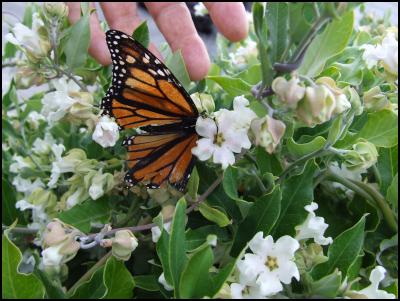Butterfly Fans Urged To Kill Moth Plant
MEDIA RELEASE
0800 002 004 |
www.nrc.govt.nz Putting Northland
first
Date: 11 February, 2013
Butterfly Fans Urged To Kill Moth Plant
The moth plant has added ‘butterfly killer’ to a resume that has already earned it the dubious distinction of being one of the region’s most unwanted pest plants and a reputation as a weed local biosecurity experts love to hate.
Sara Brill, a biosecurity officer
for the Northland Regional Council, says
moth plant
(Araujia sericifera) is a highly invasive and toxic
vine ranked among Northland’s top five non-pastoral
climbing pest plants.
“It invades and smothers native forest areas, garden shrubs, shelterbelt trees and roadside plants and its milky, sticky sap can also cause skin irritation and ill health.”
However, Ms Brill says as if there weren’t already enough reasons to heartily dislike moth plant, its flowers can also fatally trap the Monarch butterflies many Northlanders love to see around their neighbourhoods.
She says moth plants are just one of a host of dangers Monarchs face, which begin when they emerge from eggs as caterpillars.
“They’re often taken away by ravaging wasps carrying them off to feed their babies.”
Ms Brill says those caterpillars which survive wasps and other perils long enough to turn into butterflies then look around for flowers and nectar for food.
“The moth plant - or perhaps more aptly named ‘cruel plant’ as it is sometimes known - has masses of lovely flowers full of nectar at the moment. Unfortunately, what the unsuspecting butterfly doesn’t know is that this nectar is so sticky it will trap the butterfly’s tongue and it can’t get away.”
Ms Brill says the trapped butterflies often die with their tongues firmly stuck in the flower and she and a colleague had recently come across a relatively small moth plant in Whangarei that held a number of dead Monarchs trapped in its flowers.
The plant is common throughout Northland and is easily recognised by its climbing vine, with paired, oblong leaves and distinctive small, clustered white flowers which develop into choko-like seedpods. It has a white, sticky sap.
She says people keen to get rid of moth plants can remove small infestations by hand.
“Seedlings are easy to pull but even large plants can be easily killed by finding the main root and pulling out about 5cm of the root. The plant will wilt within 24 hours and you can see if you have missed any smaller ones. Pull them out on public land when you see them and offer to pull out your neighbours’ moth plants as well!”
Ms Brill says large infestations may need to be over-sprayed using 5g metsulfuron methyl (for example Escort®) plus 10 ml penetrant in 10 litres of water.
“Ensure only the foliage is treated as this herbicide can transfer in the soil and kill surrounding plants, including natives.”
Those keen to help butterflies can also plant environmentally species that are good safe sources of food for them including Alyssum, bee balm, Cosmos, Echinacea, lavender, marigolds (single petal varieties), Michaelmas daisy, Mexican sunflower, Rudbeckia, Shasta daisy, snapdragon, Solidago, sweet William, sunflower, Verbena and Zinnia.
For more information about pest animals or plants in your back yard contact the Northland Regional Council on 0800 002 004 and ask to speak to a biosecurity officer or visit www.nrc.govt.nz/nasties

Credit: Ross Johnson
The remains of a Monarch butterfly, killed when its tongue became trapped in sticky moth plant nectar.
ENDS


 Gordon Campbell: On What’s Wrong With The Treaty Principles Bill
Gordon Campbell: On What’s Wrong With The Treaty Principles Bill Mana Mokopuna: Children And Young People Share Vital Insights On Healing From Family Violence And Sexual Violence In New Report
Mana Mokopuna: Children And Young People Share Vital Insights On Healing From Family Violence And Sexual Violence In New Report NZ Government: PM Marks One Year In Government
NZ Government: PM Marks One Year In Government Helen Clark Foundation: Helen Clark Foundation Calls For Political Action To Reduce The Prevalence Of Junk Food And Improve Health Outcomes
Helen Clark Foundation: Helen Clark Foundation Calls For Political Action To Reduce The Prevalence Of Junk Food And Improve Health Outcomes Justice Committee: Further Decisions About Submissions Process For The Principles Of The Treaty Of Waitangi Bill
Justice Committee: Further Decisions About Submissions Process For The Principles Of The Treaty Of Waitangi Bill Infrastructure New Zealand: Single Agency Needed To Coordinate Climate Adaptation And Recovery
Infrastructure New Zealand: Single Agency Needed To Coordinate Climate Adaptation And Recovery Free Speech Union: Fair Digital News Bargaining Bill Likely To Restrict Access To Information, Polling Shows Most Oppose
Free Speech Union: Fair Digital News Bargaining Bill Likely To Restrict Access To Information, Polling Shows Most Oppose


